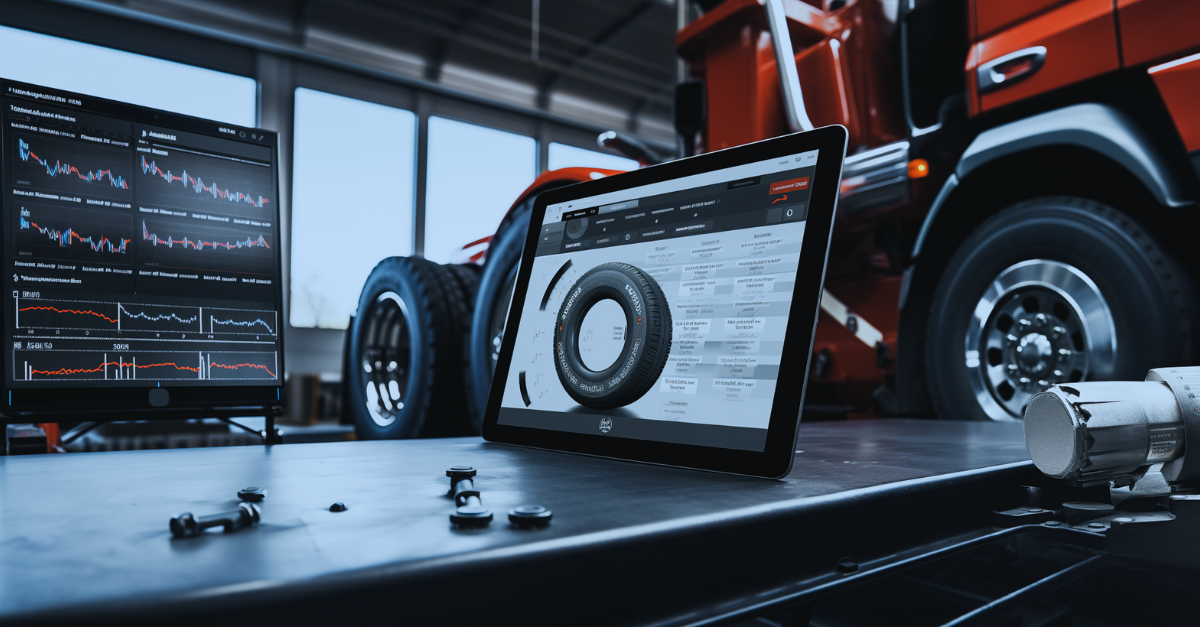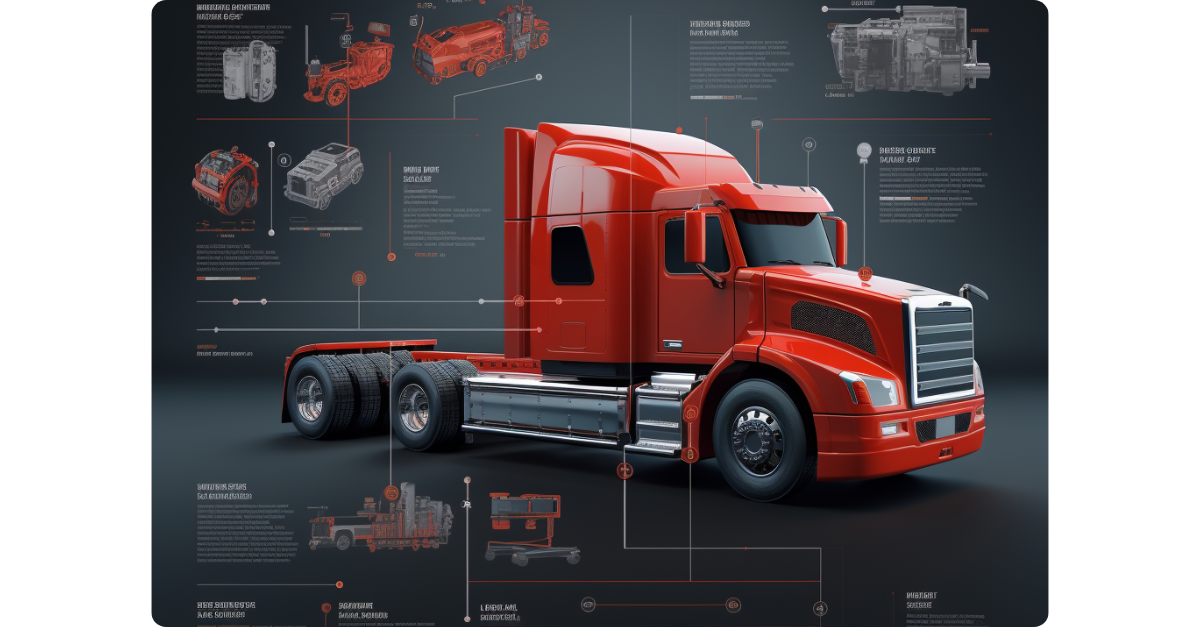Commercial Fleet Management: Strategies, Tools & Tips
Commercial fleet management plays a vital role in keeping businesses running smoothly, especially in industries like transportation, logistics, and...
Keep an eye on the road
Simplify your driver's routine
For efficient decision making
Ensure the compliance of your fleet
Simplify the daily life of your drivers
Maximize the value of your data
Unparalleled monitoring of your assets
The friendly competition that pays off
Planning powered by data
Exceed your customers' expectations
Provide better service to your users
Maximize the satisfaction of your citizens
Simplify your daily life on the construction site
Facilitate the electrification of your fleet
Our experts meet your needs
Easily meet the standards
Improve the safety of your drivers
Protect your data and your fleet
7 min read
Miguel Lage
Oct 2, 2023 12:54:47 PM

Tire Monitoring Systems (TMS) are essential instruments for operational efficiency and enhanced road safety in commercial trucking. Blending cutting-edge technology with day-to-day utility, TMS goes beyond merely displaying real-time tire metrics. They are a comprehensive resource for preventive maintenance, informed decision-making, and safer road conditions. This Blog article delves into the multiple ways TMS is transforming the trucking sector, examining everything from basic functionalities like pressure and temperature monitoring to the high-level analytics offered by the latest systems.
In the past, tire monitoring was done without sensors, real-time data analytics, or artificial intelligence. Instead, it relied on basic but crucial techniques. While these methods may seem simple compared to today's advanced approaches, they paved the way for modern tire monitoring systems. Knowing about these traditional methods can help us appreciate the significance and progress of tire maintenance in the trucking industry.
In the history of trucking, manually inspecting tires is a simple and long-standing monitoring method.
One crucial component of the manual inspection involves a visual examination conducted by operators. During this process, they carefully inspect for any indications of damage, such as cracks, bulges, or foreign objects lodged within the tread. While this method may seem straightforward, it offers the advantage of human intuition, as experienced operators often identify issues that machines may miss.
A simple yet efficient technique for assessing tire condition is the hand test. Drivers can run their hands over the tire's surface to detect any abnormalities, such as imbalances or soft spots, that may suggest internal damage. This hands-on approach has proven invaluable in preventing dangerous blowouts for many truck drivers.
While human intuition and experience guide manual inspections, mechanical tools provide more objective and quantitative evaluations.
Proper air pressure is crucial for a tire's performance and lifespan. To ensure this, it's essential to use mechanical pressure gauges that measure the pounds per square inch (PSI) of air in the tire. These gauges provide accurate readings, which can prevent both underinflation and overinflation, which have risks.
Tire health can be measured accurately by specialized tools determining the tread depth, indicating when a tire needs replacing.
While traditional methods have their merits, they also come with their share of limitations.
Manual inspections are susceptible to human error. A rushed or inattentive examination can easily miss a critical issue, putting the driver and the load at risk.
Traditional methods often require more time, a precious commodity in the fast-paced world of commercial trucking. Time spent on extensive manual checks is not spent on the road, affecting overall operational efficiency.
Mechanical tools, though reliable to an extent, cannot provide real-time data. In situations that require immediate action, such as a sudden loss of pressure, traditional methods fall short, unable to offer instant alerts or updates.

The commercial trucking industry is moving towards a digital future, and the emergence of Tire Monitoring Systems is a significant development. Although traditional methods have been useful, modern TMS has the potential to bring higher levels of safety, efficiency, and real-time data analysis. This technological advancement is not just a fad but a crucial shift towards improved road safety and operational productivity.
Tire Monitoring Systems operate on a deceptively simple yet profoundly effective principle: constant real-time surveillance.
The TMS uses sensors placed strategically to constantly monitor parameters such as tire pressure, temperature, and tread depth (in advanced versions). These sensors are designed to withstand harsh road conditions, ensuring dependable data even under challenging circumstances.
After collecting, the data is wirelessly sent to a centralized control unit, which is typically integrated into the vehicle's telematics system for a seamless user experience.
A Tire Monitoring System's efficiency and reliability come from the well-coordinated interaction between its multiple components, not just the sensors.
These are the front-line soldiers of any TMS, directly in contact with the tires. Modern sensors are not just durable; they're also incredibly accurate, providing data with minimal margin for error.
The control unit serves as the central hub of the system. It receives input from different sensors, processes the data, and can send notifications or suggestions to the driver or fleet manager as needed. The unit is usually connected to cloud storage, allowing for extended data analysis and remote monitoring.
A user-friendly interface is an essential component of any system. The TMS interface can be accessed through a smartphone app or onboard computer, providing a real-time overview of tire conditions. With advanced interfaces, predictive analytics can alert you to potential issues before they become significant problems.
In advanced trucking, TMS refers to various technologies designed for specific needs and purposes. Fleet operators and individual truck owners must understand the different TMS technologies available to make informed decisions. The market offers a variety of options, from basic Direct Tire Pressure Monitoring Systems to more advanced solutions that integrate telematics.
Direct Tire Pressure Monitoring Systems (dTPMS) have emerged as the go-to solution for many commercial and individual applications.
Equipped with pressure sensors directly mounted onto the tire or wheel assembly, dTPMS provides immediate and highly accurate tire pressure readings. These sensors measure the air pressure inside the tires and relay this data to a central control unit.
Due to its high accuracy and real-time pressure monitoring, dTPMS is widely used in commercial trucking, where even a slight variation in tire pressure can have significant consequences, from reduced fuel efficiency to increased risk of tire blowouts.
Indirect systems offer a more economical but less precise alternative to PMS.
Rather than measuring tire pressure directly, iTPMS relies on existing vehicle sensors, like wheel speed sensors, to gauge tire pressure levels. While cost-effective and easier to install, iTPMS is generally less accurate than dTPMS, making it a less ideal choice for commercial applications where precision is paramount.
iTPMS is often suitable for smaller vehicles or applications where extreme accuracy is not crucial. Some fleet operators with tight budgets opt for iTPMS as an entry-level solution before upgrading to more sophisticated systems.
Tire Monitoring Systems that are advanced and integrated with Telematics is a symbol of innovation in the ongoing search for optimal fleet efficiency and road safety. These cutting-edge systems provide more than just real-time data; they represent a new era of predictive analytics and complete vehicle management, setting new benchmarks for the trucking industry. In this article, we explore the details of Advanced TMS, including its essential components, functions, and the undeniable advantages it brings to modern fleet management.
While traditional and even some modern TMS focus primarily on tire pressure and temperature, Advanced TMS with Telematics takes this several steps further.
One of the cornerstones of Advanced TMS is its ability to aggregate a vast array of data points beyond just tire metrics. Engine performance, fuel consumption, braking efficiency, and more are collected in real-time, offering a comprehensive picture of the vehicle's health.
All this data is funnelled into a centralized telematics dashboard, accessible via mobile or desktop, which simplifies monitoring and allows for quick, data-driven decisions.
Perhaps the most revolutionary feature of Advanced TMS is its application of predictive analytics, a byproduct of machine learning algorithms analyzing historical data.
Advanced TMS systems are designed to spot trends and anomalies in tire performance and other vehicle metrics. When an issue is forecasted, the system sends immediate alerts, allowing for preemptive actions that can prevent costly or even dangerous situations.
The analytics capabilities also extend to customized reporting. Whether you're monitoring one truck or an entire fleet, these reports can be tailored to focus on key performance indicators crucial for your operations.
What makes Advanced TMS particularly compelling is its seamless integration capabilities.
Advanced TMS can be easily plugged into existing telematics systems, creating a unified platform for all your monitoring needs.
These integrated systems are generally cloud-based, allowing for remote updates and easy scalability as your fleet grows or your needs evolve.

Ensuring road safety is paramount for fleet managers and commercial truck operators. Tire Monitoring Systems have revolutionized modern trucking and become essential tools in improving fleet efficiency while significantly elevating road safety standards. This comprehensive analysis will shed light on how TMS plays a direct role in enhancing road safety.
In the fast-paced environment of commercial trucking, immediate notification about tire issues can be a game-changer.
Real-time alerts have a significant advantage in empowering drivers to take immediate action upon receiving critical information. Whether a tire pressure drops below the optimum level or an abnormal temperature spikes, instant notifications enable quick corrective actions, preventing potential accidents.
Preventing an issue before it arises is the epitome of adequate safety measures; this is where predictive analytics comes into play.
Advanced TMS systems with predictive analytics algorithms analyze historical and real-time data to predict possible future tire failures. From identifying uneven tire wear to forecasting potential blowouts based on current usage patterns, predictive analytics offer a proactive approach to maintaining tire health, thereby reducing the risk of road incidents.
When deployed across a fleet, the benefits of TMS extend well beyond individual trucks, resulting in an intricate safety net that adds layers of security.
By facilitating optimal tire pressure and tread condition, TMS aids in maximizing fuel efficiency and minimizing tire replacement costs. But these economic benefits have a direct safety correlation, too. Better fuel efficiency often translates to fewer fuel stops, thus reducing the time trucks spend parked dangerously on the sides of busy highways.
Some advanced TMS comes integrated with the Global Positioning System (GPS) and can be linked to emergency road services. In the event of a tire failure or other critical issues, the closest emergency services can be dispatched immediately, reducing downtime and potential hazards.
One of the standout features of AttriX's offerings is integrating the ContiPressureCheck™ system via the Geotab Marketplace. Designed to meet the complex demands of modern fleet management, this integration represents a significant advancement in TMS.
The ContiPressureCheck™ system can be easily connected to the MyGeotab app using the GO device from Geotab. This system offers drivers instant access to vital tire pressure and temperature information, allowing them to take corrective action immediately. The system's accuracy is exceptional and can detect and prevent tire-related problems before they become expensive.
This product includes an advanced alert system that issues low-pressure alerts of varying severity. These notifications serve as early warnings for drivers and fleet managers, enabling prompt action for safer and more efficient fleet operations.
The information obtained through ContiPressureCheck™ provides immediate problem-solving and a valuable long-term analysis that can help make well-informed decisions. This all-in-one solution offers numerous financial benefits, including decreased expenses on tires and more extended durability of tread.
Integrating ContiPressureCheck™ through AttriX on the Geotab Marketplace is a valuable tool for modern fleet management. Utilizing real-time data and predictive analytics helps fleets achieve their safety and efficiency goals. This integration offers reliable and comprehensive TMS solutions for fleet operators, which can improve safety and operational efficiency. With immediate safety concerns addressed, it allows for broader operational enhancements.

Commercial fleet management plays a vital role in keeping businesses running smoothly, especially in industries like transportation, logistics, and...

In fleet management, fleet compliance services play a much bigger role than just checking a box. They’re about keeping your drivers safe, your...

Trucking has always come with its fair share of challenges, from road safety and liability issues to managing fleet efficiency. As the industry...